In the beginning of recording adventures the recording process itself was facing some challenges, so among other issues bass modulation became excessive and overcutting took place, with the cutter into the next record groove. Audio engineers developed some measurements, also using pre-emphasis and de-emphasis.
In processing electronic audio signals, pre-emphasis refers to a system process designed to increase (within a frequency band) the magnitude of some (usually higher) frequencies with respect to the magnitude of other (usually lower) frequencies in order to improve the overall signal-to-noise ratio by minimizing the adverse effects of such phenomena as attenuation distortion or saturation of recording media in subsequent parts of the system. That is the mirror of the de-emphasis. The whole system is called emphasis. The frequency curve is decided by special time constants. The cutoff frequency can be calculated from that value.
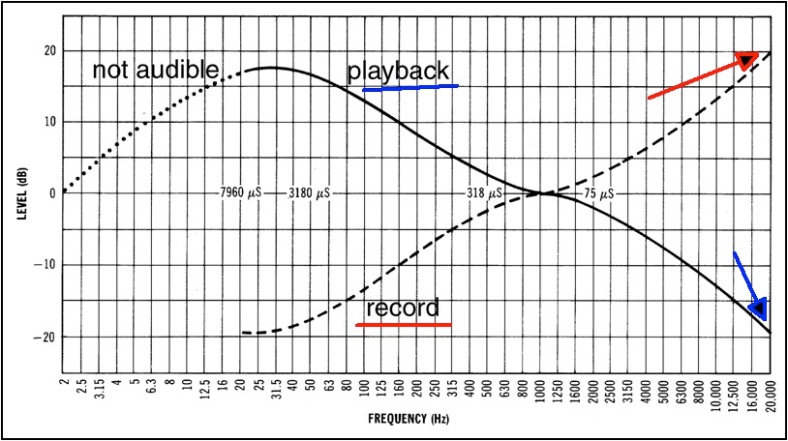
The usage of pre-emphasis above 1.000 Hz in 78 and 33 1/3 rpm records started some 29 years before the RIAA curve (Recording Industry Association of America) was accepted as industrial standard. The RIAA curve defines transition points which correspond to 2.122 Hz, 500 Hz and 50 Hz. After a “market war” between Columbia and RCA Victor by the time of the Stereo LP in 1958, the RIAA curve, identical to the RCA Victor New Orthophonic curve, became standard throughout national and international record markets.
It is suspected that many records were still using EQ curves other than the RIAA well into the 70s. As a result, recently more and more high-end audio manufacturers have been bringing out Phono Equalizers with selectable EQ curves, including options for e.g. Columbia, Decca, EMI, Neumann and TELDEC’s Direct Metal Mastering.
Why should the vinyl user of today consider thinking about different equalization curves other than RIAA and which effect or advantages do other curves provide for the vinyl entertainment?


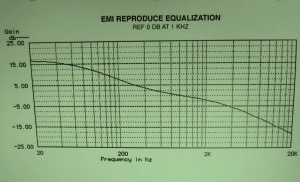
Most audiophiles believe using a special EQ curve on a record may change or smooth the sound to quite some extent. This is not the case. It is more or less the correct answer to the put question – equalization when recording. Nevertheless correct replay curves have a profound effect on the tonal balance of the recordings.
There are different types of phono stages providing equalization. The Boulder 2008 or the Zanden 1200 are respectively coming with three curves each.
In the pictured Boulder unit RIAA is fitted as a standard but two other internal PCB`s are installed, Columbia and EMI (in front of the blue compartment), that activate the other two EQs switches on the front plate.
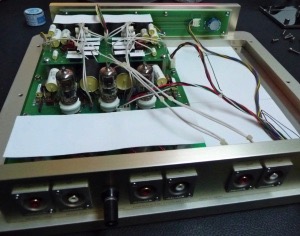
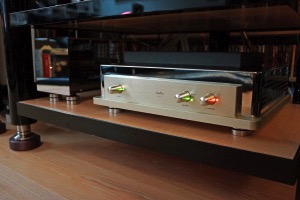
The Zanden 1200 MK II allows the user to choose between the RIAA, Columbia and DECCA equalization curves by the simple turn of a mercury rotary switch but the MK III version attracts by the addition of EQ curves for Teldec and EMI LPs.


The EMT JPA-66 (the PS above) provides a fully variable equalization filter, one can easily adjust to the unofficial, but relatively often used RIAA+Neumann curve. This curve has only ½ dB difference to the RIAA at 20.000 Hz , but a roll of at 35.000 Hz. As a result you`ll notice, especially with modern records, an extended and more open high tone range.
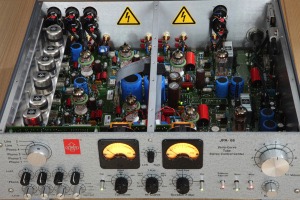

The variable filter curves can be selected very easily. Ideally one would use a 78 rpm record with sung music and start with the following selections and settings:
- Turnover – RIAA
- Hf-curve – 50 us
- Scratch filter – off
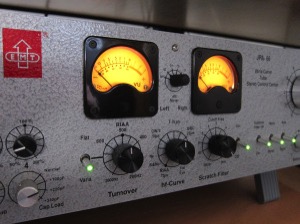
While listening specifically to the voice it is recommended adjusting the turnover knob to the left and right optimizing the position where the voice sounds most natural. This would then be the correct turnover frequency for this particular record. In the next step while listening to the higher frequencies one may turn the Hf-curve knob towards 0 looking for a position where the high frequencies are optimally balanced. The rule of thumb is: the older the record the smaller the number for this adjustment.

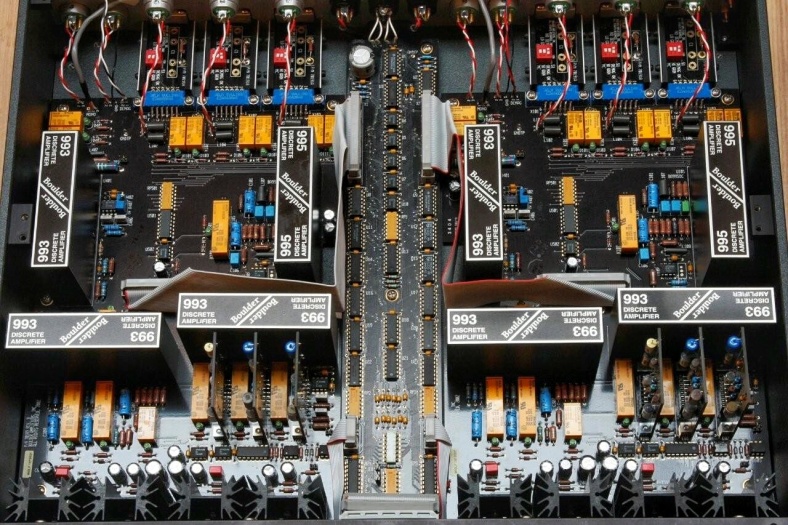


Other phono stages like the SENTEC EQ 10 Tube Mono Phono Preamp or the Wavestream Kinetics Archival Phono Stage allow several hundreds EQ curves for early mono and all 78 rpm records or for the latter different modular EC cards. The FM Acoustics Phono is another serious contender in this very exclusive field.
Regarding the question which records should be considered as non RIAA compatible there is a strong belief only pre 1955 stamped records need to be treated by alternative curves, meaning only for a small group of special collectors it is worth investing in expensive phono stages providing more flexibility on EQ curves. Following the fierce controversies among collectors when it comes to the question of the relative sonic merits of Wide-bands versus Blue-backs one may get the impression the equalization issue might be a niche for madcaps. This is not the case!
The Neumann curve, for example, has a roll-off at 35,000 Hz, the RIAA at >50,000. For this reason, “Neumann records“ sound somehow muted with a RIAA equalization, which then again leads to the fact that many high-end systems (with RIAA) require a highness(over) emphasis in order to be able to play these records “appropriately“.
A more or less proper EQ correction is carried out by many Preamps.
The trick, however, is not only to correct the amplitude response depending on the frequency but not to adversely affect neither phase nor impulse response.
Many High End friends were asking me whether the alternative equalizations can be used for stereo records or not? Some poeple believe DECCA, EMI, Columbia and other curves can be used only as a form of tone control replaying stereo records.
Let me put some more light into this almost forgotten chapter of vinyl history. Before 1957, each record company applied its own equalization; there were over 100 combinations of turnover and rolloff frequencies in use. While in 1958 the agreed RIAA standard was established English and French and some other nations`engineers still used their own curves, mostly because the wanted adjusting deviances of their own microphones and amplifiers. So it took at least until 1960 that most of the labels were adopting the RIAA curve. For most of the Stereo records after 1960 recording engineers were using the RIAA curve..
It is even possible that some record cutters were still using EQ curves other than the RIAA well into the 1970s like e.g.
Columbia, Decca, CCIR, and TELDEC’s Direct Metal Mastering.
Nevertheless the real impact of these alternative curves you may realize on original old Mono records before the Microgroove age. In case of reissues usually the RIAA standard is applied, also on fine Mono repressings like the Mosaic label is using (e.g. the Complete Commodore Jazz recordings Volume I-III).
Using the alternative curves as a kind of equalizer (tone control) is up to everyone. I wouldn`t do it. In the case of the Neumann curve you sometimes get a clearer, more open sound without loosing warmth.
From my point of view still important is the correct adjustment of the needle in the groove. In case of old Mercury records e.g. you may realize what happens when you put down the tail of the tonearm a little more…
see also: “Using the Neumann Curve” on AudioCirc.com

Eckart,
I read with great interest this most recent post. I have over a hundred microgroove jazz LPs from Atlantic, Royal Roost, Prestige, MGM, Bethlehem, Discovery, and Savoy. These are 10″ microgroove recordings @ 33.3rpm.
How can I find what eq curve they are using as none is listed on the record or the jacket?
My vintage preamp doesn’t not have an adjustable eq. curve, so I often use my preamps tone controls for a better listening experience. I have heard that one can use a graphic equalizer to recreate the de-emphasis of the curve used during the recording. Is this true?
Norman
LikeLike
Norman,
You will find lists on the web which curves the labels used. I have no experience with graphic equalizers but doubt that it is an appropriate measurement. In any case you might think about going for a phono pre providing the curves you need.
E.
LikeLike
Hello, Would you please post internal pictures of the JPA66′ PSU ? thanks !
regards ,
P.
LikeLike
Pierre,
I added two images of the Power Supply.
E.
LikeLike
Thanks Eckart ! Quite large transformer for a preamp !
regards
Pierre
LikeLike
The idea that any equalization other than RIAA was used in the cutting of stereo LPs is pure nonsense. EMI changed to RIAA in 1953, Decca in 1955, American Columbia in 1955, etc. All the major companies agreed at a meeting in Zurich in 1958 to use the RIAA standards for stereo discs. The sentence about the “Neumann curve” going to 35 KHz and the RIAA curve to 50 KHz, is equal nonsense.
LikeLike
Who really knows exactly what happened by whom how and to what extent in the last 60 years? But that something happened with the equalization curves you may discover very quickly:
1. Select a record of the 60ies and liston to it on position RIIA; everything is fine.
2. Again select a good (180/200h Super deLuxe Vinyl) record of the later 80ies onward, liston to it at RIAA position and then with NE!
As you might see the topic is discussed among many experts:
https://www.stereophile.com/features/cut_and_thrust_riaa_lp_equalization/index.html
Best
E.
LikeLike
Well you certainly don’t. EMI published an article in The Gramophone in April 1956 stating that they used RIAA ; Decca issued a test disc LXT5346 in 1957 which states that Decca discs use RIAA. Columba (USA) issued a disc introducing stereo in 1958 which says that they use RIAA. The back of Mercury Living Presence Stereo says use RIAA playback and so on. You adduce no evidence whatsoever for your baseless assertions.
LikeLike
Whatever norms existed there were always producers which used and pressed with old machines (and therefore not correct norms). They did not care about changes, especially on norms (in the fifties) because many issues were under change at that times.
Also we saw so many causes that certain records with correct RIAA sounded perfect and some others shitty. Please keep this in mind!
LikeLike
Hi
I read this post with a lot of interest.
I am researching a lot about different curves used for stereo records after 1954.
I think that still, for new records pressed in Europe, the pressing plants are using Decca or Emi curves to make the lacquers.
Regards
LikeLike
I just read all these posts again, also from David Mansell, who seems not knowing that Europe other than all the pressing works in North America used other curves until the mid sixties. With the new Air Tight phono pre ATE 3011 you may discover what it means. But relax, even the great Mike Fremer was on the wrong track on this matter. Maybe you should read Uwe Kirbachs article in the new „image Hi-Fi“ at page 115.
LikeLike